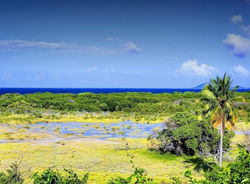
High North

Lilet Sanctuary
Mangroves Restoration
Since 1994 KIDO Foundation, under the guidelines of wetland biologist Dr. Gregg E. Moore (UNH), developed and managed the restoration of the Petit Carenage Mangrove Ecosystem, which had been severely damaged in 1955 by hurricane Janet, and later by hurricanes Ivan in 2004 and Emily in 2005. The Petit Carenage-Lilet Mangrove forest is among the most developed in Grenada (OAS/Gov.of Grenada – Plan & Policy for a System of National Parks & Protected Areas, 1988), acting as an effective buffer zone against tsunami, tidal waves, rising sea level, containment and filter of muddy runoffs from the eroding higher hills. The mangrove system is also a nursery & feeding area for many bio-diverse species (95% of coastal fish; 45 species of migratory, resident & endemic birds, crustaceans, etc.) and acts as a most efficient carbon sink in tandem with the nearshore Seagrass meadows. Coastal mangroves are also the preferred nesting grounds for Hawksbills turtles (Critically Endangered).
Until December 2021 KIDO restored approximately 11.5 acres, including 1.5 acres of critical coastal area where the saplings are now doing well. In these damaged areas KIDO planted approximately 44,000 red mangrove propagules, some with bamboo encasements. This figure includes the repeated replacement of damaged and dead saplings caused by drought, roaming cattle and mangrove crabs (approximately 30%).
Over 8000 red mangrove propagules were harvested and planted with a much reduced KIDO staff during the last two Covid-19 years, working in accordance with the necessary public movement restrictions and regulations in the State of Grenada. Throughout the past two decades, university students from SGU and abroad, groups of local students and teachers, and many eco-tourists joined our KIDO team assisting in the mangrove restoration in the barren wetland that was once a flourishing and productive coastal forest.
 |
|---|
 |
 |
 |
 |
 |
 |
 |
 |
 |
 |
 |
 |
 |
 |
 |
 |
 |
 |